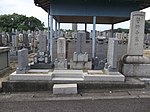Suzuki Akira (Linguist)
Suzuki Akira ( Japanese 鈴木 朖 with the stage name Suzuki Hanareya ( 鈴木 離 屋 ); born April 3, 1764 in Owari Province ; died July 8, 1837 ) was a Japanese literary theorist , linguist and advocate of national teaching during the later Edo period .
Life
Suzuki Akira was born as the third son of the doctor Yamada Jūzō ( 山田 重 蔵 ) who worked in Owari-han . From 1771 he studied Nanga painting under Niwa Yoshinobu ( 丹羽 嘉言 ; 1742–1786), then from 1775 the teaching of Confucius under a master student of Ōuchi Yūji ( 大 内 熊 耳 ; 1697–1776), namely under Ichikawa Kakumei ( 市 川 鶴鳴 ; 1740-1795). He became known at a young age, for example through the "story about a resident of O Castle [Nagoya Castle]" ( 尾 城 人 物語 , Ojōjin monogatari), which he published at the age of 15. From 1781 he continued the family of his grandfather Suzuki Ueimon ( 鈴木 右衛門 ).
When the school of Owari-han was opened under the name Meironkan ( 明倫 明倫 ) in 1783 , the Confucianist and director Hosoi Heishū ( 細 井 平洲 ; 1728–1801) wanted to persuade him to work, but Suzuki refused. At the time, Suzuki published "Thoughts and Questions" ( 思 問 録 Shimon-roku ), a script in which he analyzed Arai Hakuseki's script "Sairan igen" ( 采 覧 異言 ). In 1785 he copied a series of writings that Motoori Norinaga had written and thus showed an interest in linguistics.
In 1789 Suzuki went to Edo and came into contact with Confucianists such as Ogyū Sorai (1666–1728) and Minagawa Kien (1734–1807), as well as with the work on the Japanese language by Norinaga and Fujitani Nariakira (1738–1779). 1792 Suzuki, together with Ishihara Masaaki ( 石 原 正 明 ; 1760-1821), pupil of Motoori Norinaga. Suzuki listened to Norinaga's lectures when he was in Nagoya. In 1821, Suzuki was promoted to Chief Confucianist of the Owari-han. In 1824 Hirata Atsutane noticed him. From 1833 the national doctrine, following the fashion, should also be taught at the Han school. The chair created for this purpose was transferred to Suzuki.
Suzuki's ideas influenced Norinaga's son, Motoori Haruniwa (1763-1828), and Tōjō Gimon (1786-1843). In 1834 Suzuki moved again within Nagoya, fell ill and died three years later.
To the work
One of Suzuki's work on Japanese grammar that has received the most attention is his theory of word classes, similar to the classification of the European language. His main classes were
- tai no kotoba ( 体 の 言葉 ), "substance words", i.e. nouns,
- arikata no kotoba ( 在 り 方 の 言葉 ), "words of status", adjectives,
- shiwaza no kotoba ( 仕 業 の 言葉 ), "words of action", verbs,
- te-ni-o-ha ( て に を は ), non-derived adverbs, prepositions, conjunctions, interjections.
He distinguished between the first three classes, which express concepts that the mind uses to organize experiences, and the fourth class. This expresses mental activity directly. This distinction was later taken up by the modern grammar specialist Tokieda Motoki (1900–1967) and further developed.
Remarks
- ^ Reprint from 1930.
- ↑ In the Seigan-ji cemetery ( 誓願 寺 ), but now in the Heiwapark ( 平和 公園 ) of Nagoya .
Publications (selection)
Suzuki's best-known works on Japanese grammar include
- Gengyo shishu ron ( 言語 四種 論 ), published 1824, and
- Katsugo danzoku fu ( 活 語 断 続 譜 ), published posthumously.
literature
- S. Noma (Ed.): Suzuki Akira . In: Japan. An Illustrated Encyclopedia. Kodansha, 1993, ISBN 4-06-205938-X , p. 1487.
Web links
| personal data | |
|---|---|
| SURNAME | Suzuki, Akira |
| ALTERNATIVE NAMES | 鈴木 朖 (Japanese) |
| BRIEF DESCRIPTION | Japanese linguist |
| DATE OF BIRTH | April 3, 1764 |
| PLACE OF BIRTH | Owari Province |
| DATE OF DEATH | July 8, 1837 |

